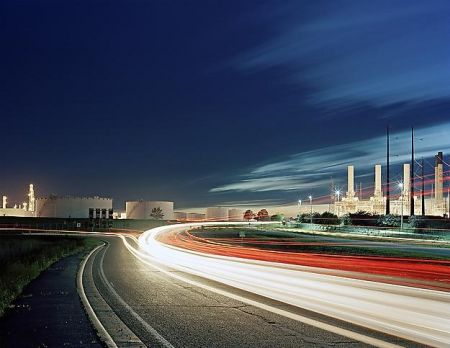August 29, 2012
Human beings are curious and creative animals that revel in the experience of the unknown. But with the embrace of modernism, particularly through electronic technology, we have become trapped in a culture that is perilously dependent on industry, which in turn, goes to great strides to seduce, manipulate, and coerce its consumers while keeping its failures a secret --carefully hidden from public scrutiny. Yet the myth is but a mirror projection, and the truth beyond it is like a black abyss; our consumer appetites are disproportionate to what the natural world can provide; our way of life cannot displace what we would rather ignore forever.
It’s the sort of scenario Canadian environmental policy analyst and indigenous rights activist, Ron Plain, symbolizes in the dream-catcher, spoken recently at panel discussion entitled “Contested Futures, Tar Sands and Environmental Justice. Reports on front-line resistance,” at the University of Toronto. The dream-catcher relic, as commonly told in folklore served as a protection. A circular web like construct, often made of woven leather, the mythological dream-catcher was believed to capture negative spirits in its web. For Ron Plain, Sarnia, Ontario is the centre of the dream-catcher; a nexus point for Canada’s industrial and economic expansion infrastructure, and a living nightmare for the people of the Aamjiwnaang.
For many years, Ron Plain has been an advocate and spokesperson for his hometown community of Aamjiwnaang, a First Nation reserve situated near the southernmost tip of Lake Huron, on the border between Ontario and Michigan, neighbouring the city of Sarnia Ontario where within an approximate 25 kilometre radius, 62 industrial refineries currently produce as much as 40% of Canada's chemical manufacturing.
“Contested Futures” was an important speaker event that touched on a number of different issues generally linking the environment, industry, and government, to the plight of the Canadian indigenous living on reserve land. The highlighted issue of the evening, however, was the recent approval by the National Energy Board (NEB) of the Enbridge proposal to retrofit one of it’s pipelines to transport tar sands crude from Alberta into Ontario, to then be exported to U.S. refineries.
Enbridge's $16.9 Line 9 Reversal project is said to be a “Phase 1” proposal. Within the last year, Enbridge's Northern Gateway pipeline proposal has raised concerns, fears, and a formidable resistance effort on the part of indigenous and environmental activists across the nation. Public hearings held earlier in the spring in London Ontario were temporarily shut down by the London Occupy movement, when Enbridge and NEB received a “mic check” by members of the local Haudenosaunee First Nation. Aamjiwnaang Chief, Christopher Plain, also present, was allowed to speak as an official, and told the board that the pipeline reversal project would likely exacerbate already pervasive health problems in his community. It was cause for disappointment but no surprises when the board concluded in final statement that “any potential impacts on aboriginal interests” would be “minimal and appropriately mitigated.”
“The World Health Organization labelled us the most contaminated air shed in the world!” Ron Plain would go on to say, describing Aamjiwnaang as a signing canary within the global scientific community. Evidence of contamination in the air and water has been definitively linked to a skewed birth ratio in Aamjiwnaang; scientists are alarmed because it points to the likelihood of “endocrine disruption” the altering of human DNA by environmental toxins. Aamjiwnaang is translated to mean “where the rivers flow from.”
Ecojustice, an environmental and legal advocacy group that has worked with Ron Plain and the Aamjiwnaang community for many years released a report in 2007, “Exposing Canada’s Chemical Valley” in which testimony was taken from residents who described the living conditions in the environment in which “accidents, spills, releases and tests at industrial sites” were “not uncommon” and that “explosions, vibrations, and alarms” could be routinely heard. This, they said, “combined with the continued approvals to emit air pollution handed out by the government to industry in the area causes residents to be in a constant state of fear for their health.”
The Chemical Valley report, purported to be the first of it's kind in the sort of research it that was conducted. In analyzing statistics issued by the both the Canadian and U.S. government's very own air pollution registries, Ecojustice said that they found the data to be “particularly striking” in that the amount of toxic pollutants released by the facilities in the Sarnia area emitted up to “5.7 million kilograms of “Toxic Air Pollutants,” including numerous chemical associated with reproductive and developmental disorders and cancer among humans.” They identified certain “pollutants of concern” present in high concentrations within the Chemical Valley region, including “sulphur dioxide,” “hydrogen sulphide,” “carbon monoxide,” “particulate matter, and benzene.” Furthermore, according to resident testimony “strong odours, fumes and particulate fallout have been experienced by residents of Aamjiwnaang.” On occasion, they reported, officials would caution residence “to reduce their exposures to harmful substances,” by staying indoors.
“Exposing Canada's Chemical Valley” was part of a legal challenge by Ecojustice that was finally submitted to the Ontario Ministry of the Environment, in which they advised the ministry to look at how the “cumulative effects” were impacting the Aamjiwnaang community, and to regulate industry accordingly. Some of the top polluters named in the report included industrial giants such as Suncor, Imperial Oil, Shell and Enbridge. As of February 2012, Ecojustice has since filed a lawsuit, on behalf of Plain and members of the Aamjiwnaang First Nation in response to the Ontario Ministry of the Environment decision to allow continued “permitting” of air pollution to the industrial refineries.
Ron Plain has visited Toronto on at least three separate occasions within the last six months, including Occupy Toronto's “Occupy Talks" series, this year's annual Canadian “Mining Resistance Conference,” and finally “Contested Futures.” When Plain addresses audiences he makes a the point repeatedly to criticize leading environmental proponents, like David Suzuki and the World Wildlife Fund, for their silence. The desperate fight of the Aamjiwnaang First Nation is similar in so many respect to the fight happening on numerous Canadian indigenous reserves and yet the youth of today, tomorrow’s leaders, remain woefully uninformed and in the dark about this silent genocide.
While social movements like Occupy offer a ray of light and some proof that this generation has “woken up” to a lot of problems, they have yet to grasp the their role of responsibility they have stepped into. The hope of the Occupy movement, over all others, was in it’s unrelenting commitment to adhering to the principles that made it an authentic movement: Direct democracy, listening and valuing the equality of every person, taking a stand for the what's right, saying enough is enough, refuting the power structure, and fighting to create a better future. It is a movement that needs to realize its momentous power because it has not even begun to scratch the surface.
For too many years the environmental movement has apparently been hijacked to serve as a “green-washing" platform by pundits and proxy groups; they seem to be perpetually caught up in irrelevant debates about the existence of climate change, otherwise promoting “market driven solutions” for sustainability. These are false choices we are being given. Mainstream environmentalism amounts to little more than an attempt at appeasing one’s egotistical guilt, through making “eco-friendly” consumer choices.
These are issues that pale in significance to the kinds of human rights violations that have been knowingly and willingly imposed upon indigenous people by the industry, its elite banking financiers and government allies. In the absence of responsible leadership at nearly all levels, the choices diminish and we must come face to face with our own basic instincts. “We can't stop this,” Plain finally admitted to the audience at the conclusion of his brief talk, “but our conscience compels us... I want all of you to run for office.”

